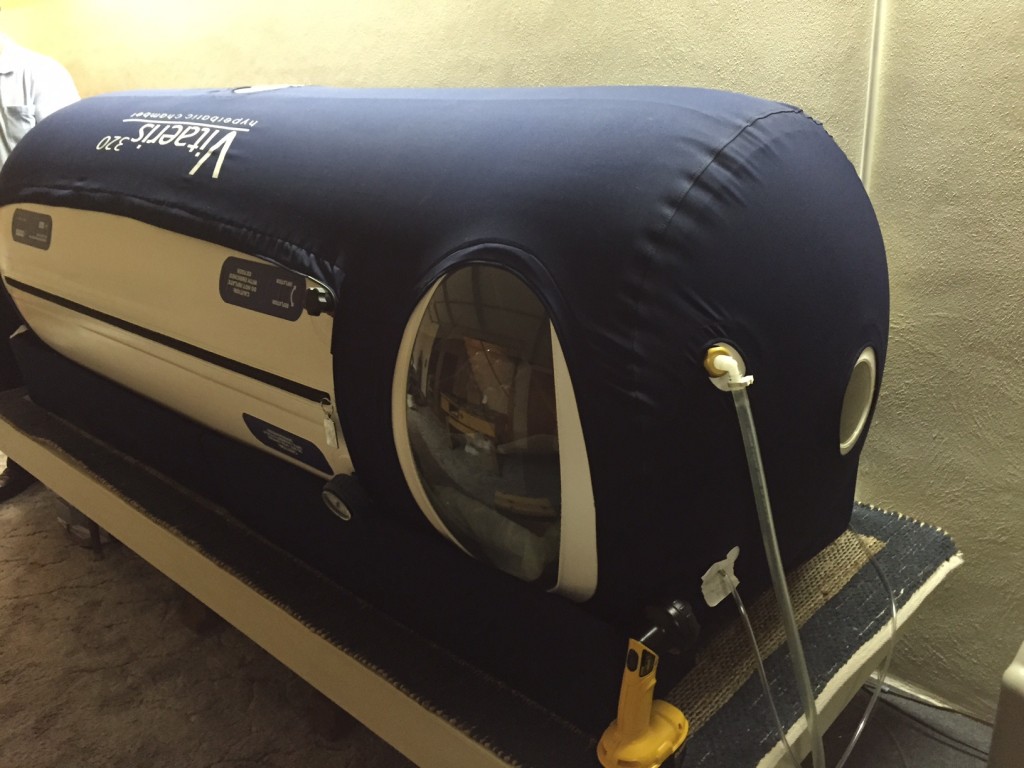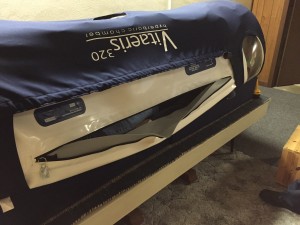My guess is that readers of this blog already know that oxygen is a principal key to the health and well-being of life on Earth. Hyperbaric Oxygen Therapy (HBOT) is a way of delivering oxygen directly to the blood, tissue, and other bodily fluids. Although it is often done in a hospital setting, especially in burn units, some individuals have purchased units for their own use. HBOT chambers come in two varieties, hard chamber (HBOT) and soft chamber (mHBOT). Hard chamber units are able to employ higher pressure to address certain kinds of problems best treated in hospital settings, although oxygen therapy is useful for many conditions beyond those considered for hospital use.
If you have watched any movies about deep see diving, you may have seen dramatic scenes of divers coming up too quickly and developing the “bends.” They are put in an HBOT chamber to recover. The HBOT units also come in sizes suitable for horses, as they can be used to help racing horses recover from injuries. Private use of chambers is limited in two ways: First, the chambers are expensive, and, second, the oxygen requires a prescription. Oxygen is, of course, highly flammable, and is best used in controlled conditions for specific purposes.
What caught my attention was that HBOT has been used to correct hearing loss. My first blog about hearing loss was Adventures in Mesotherapy, back in April of 2012. Since then, a number of my blog entries have covered my efforts to find a way to correct hearing loss. My first step was, of course, to research hearing aids. I know three people who have them: One likes his and wears them with regularity; one wears his only when watching TV so that his wife won’t complain about the sound being too loud, and one wore his for about six months and then put them in a drawer. That seems to be the case with many who have bought them. The article, Why My Hearing Aids Are in the Drawer, provides a good summary of consumer complaints about hearing aids. That article convinced me that I would do well to find another way if possible and to think of hearing aids as a last resort, essentially same way I think of surgery and pharmaceuticals.
Several of my previous blog entries have covered my explorations of various interventions to improve hearing. My interest in Hyperbaric Oxygen Therapy came about the same way, and when Debra mentioned that one of her husband’s relatives had a soft chamber, I asked her to check with him to see whether it might help my hearing. She did and arranged an appointment for me. She accompanied me on the journey, not only because she knew John, the owner of the mHBOT chamber, but also because she wondered about the degree to which she would find time in the chamber helpful for her or some of her clients. After a preliminary interview that covered some of the aspects of my medical history important for chamber use, John introduced us to the HBOT chamber:
A warning to the claustrophobic: If you are at all claustrophobic, you would do well to see an NLP practitioner and experience the Fast Phobia Cure before trying an mBOT chamber. It’s definitely a tight fit, and the only way in is to crawl in head first and then roll over. The oxygen is delivered through a mask similar to the masks used on airlines when pressurization fails.
Once the person is inside and comfortable, the oxygen is turned on, and the chamber is double-zipped shut. The chamber is pressurized gradually to give the person’s ears time to adjust to the higher pressure. The sensation is similar to but more intense than the “ear popping” that often accompanies changes in cabin pressure when airplanes change altitude quickly for taking off and landing. The process of inflation took about 15 minutes, and John checked to see how I was doing with regularity because some people have trouble adjusting to the increasing pressure. Although I had some pain in my ears, it wasn’t bad, and it went away as I got used to the pressure. Here’s what the chamber looks like when fully inflated:

I’m not sure at what point I fell asleep. John woke me up after I had been in about an hour, and gradually reduced the pressure in the chamber. When the pressure had returned to normal, he unzipped the chamber, and I removed the oxygen mask. Although I felt a bit disoriented, I was able to get out of the chamber but was glad for the opportunity to sit soon after exiting. I found the postchamber feeling similar to the feeling I often have following acupuncture. I told Debra that I would be glad to let her drive.
During my postsession interview, John suggested that some my health concerns might be addressed by Food Grade Diatomaceous Earth. It’s inexpensive—you can even say “dirt cheap”—so I was willing to try it. Diatomaceous Earth is primarily silica, and here’s a brief list of the known health benefits of silica as a supplement:
- Silica lowers bad cholesterol and raises good.
- Silica can normalize circulation and regulate high blood pressure (hypertension).
- Silica stimulates metabolism for higher energy levels.
- The presence of sufficient silica in the intestines will reduce inflammation of the intestinal tract. It can cause disinfection in the case of stomach and intestinal mucus and ulcers. Silica can prevent or clear up diarrhea and its opposite, constipation.
- In regulating and normalizing the bowels, silica has a pleasant side effect; it can alleviate lower back pain, which often troubles the elderly.
- Silica works with other antioxidants to prevent premature aging and to preserve youthfulness.
- In regulating and normalizing the bowels, silica has a pleasant side effect; it can alleviate lower back pain, which often troubles the elderly.
- Silica has inhibitory effects on coronary diseases.
And that’s just a partial list. For more information, see Food Grade Diatomaceous Earth and especially the list of benefits at the end of the article.
As is often the case with the things I have been trying, I do not have the kind of nice, neat A-B comparison required for scientific validity. I have no way to test for the influence of the placebo effect. Nor do I have a way to separate the influences of one of the things I have been doing from the influences of the others. My hearing has been improving gradually, and I have no way of knowing whether one of my efforts is making most of the difference, or whether it is the combination that seems to be working. I’m also not sure that makes a difference.
It may be that the journey is more important than the destination, that the seeking is more important than the finding. If hearing is an issue for you or someone you know, be sure to check back. I will doubtless address this subject again in a future blog article.



